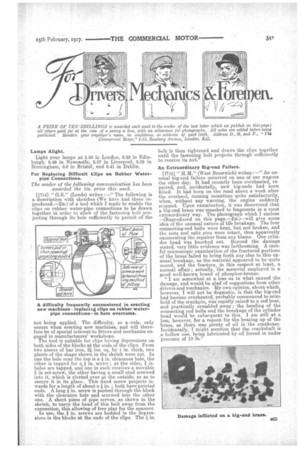A PRIZE OF TEN . SHILLINGS is awarded each week to
Page 21

If you've noticed an error in this article please click here to report it so we can fix it.
the sender of the best letter which we publish on this page; all others paid for at the rate of a penny a line, with an, allowance for photographs. All notes are edited before being publiated. Mention your employer's name, in confidence, as evidence of good faith. Address D., hi, and F., "The Commercial Motor," 7-15, Bosebery Avenzie, London, E.G,
Lamps Alight.
Light your lamps at 5.50 in London, 6.22 in Edinburgh, 5.49 in Newcastle, 5.57 in Liverpool, 5.55 in Birmingham, 6.0 in Bristol, and 6.41 in Dublin.
For Replacing Difficult Clips on Rubber Water. pipe Connections.
The sender of the following communication has been awarded the Ws. prize this week.
[1714] " G.S." (Leeds) writes :—" The following is a description with sketches (We have had these reproduced.—En.) of a tool which I made to enable the clips on rubber water-pipe connections to be drawn together in order to allow of the fastening bolt projecting through its hole sufficiently to permit of the nut being applied. The difficulty, as a -rule, only occurs when erecting new machines, and will therefore be of special interest to fitters and mechanics engaged in manufacturers' workshops.
The tool is suitable for clips having depressions on both sides of the blocks at the ends of the clips. From two pieces of bar iron, 24 ins. sq. by 1 in. thick, two plates of the shape shown in the sketch were cut. In one the hole near the top is a 4 in. clearance hole, the other is tapped for a, 4 in. screw ; at the sides, I in. holes are tapped, and one in each receives a movable in set-screw, the other having a small stud screwed into it, .which is riveted over at the outside, so as to secure it in its place. This fixed screw projects inwards for a length of about a 4 in. ; both have pointed ends. A long 4 in. screw is pushed through the block with the clearance hole and screwed into the other one. A short piece of pipe serves, as shown in the sketch, to tarry the head of this bolt away from the connection, this allowing of free play for the spanner. In use, the in. screws are bedded in the depressions in the blocks at the ends of the clips. The 4 in.
bolt is then tightened and draws the clips together until the fastening bolt projects through sufficiently to receive its nut."
An Extraordinary Big-end Failure.
fr715] " H.M." (West Bromwich) writes :--" An unusual big-end failure occurred on one of our wagons the other day: It had recently been overhauled, repaired, and, incidentally, new big-ends had been fitted. It had been on the road about a week after the overhaul, running meantime quite satisfactorily, when, without any warning, the engine suddenly stopped. Upon examination, it was discovered that a big-end brass was smashed to fragments in a most extraordinary way. The photograph which I enclose —(Reproduced on this page.—En.)--will give some idea of the unusual nature of the breakage. The four connecting-rod bolts were bent, but not broken, and the nuts and split pins were intact, thus apparently exonerating the repairer from any blame. One cylindor head was knocked out. Beyond the damage stated, very little evidence was forthcoming. A careful microscopic examination of the fractured portions of the brass failed to bring forth any clue to this unusual breakage, as the material appeared to be quite sound, and the fracture, in this respect at least, a normal affair ; actually, the material employed is a good well-known brand of phosphor-bronze.
"I am somewhat at a loss as to what caused the damage, and would be glad of suggestions from other drivers and mechanics. My own opinion, about which, however, I will not be dogmatic, is that the big-end had become overheated, probably commenced to seize hold of the crankpin, was rapidly raised to a red heat, and practically crumbled away ; the bending of the connecting rod bolts and the breakage of the cylinder head would be subsequent to this. I am still at a loss, however, for a reason for the heating up of the brass, as there was plenty of oil in the crankcase. Incidentally, I might mention that. the crankshaft is a hollow one, being lubricated by oil forced in under pressure of 10 lb.."






















